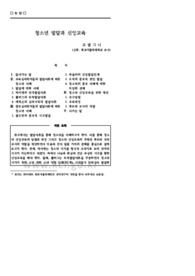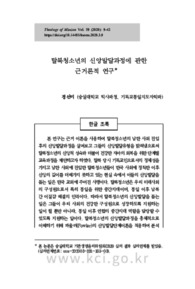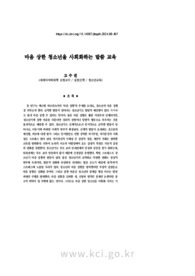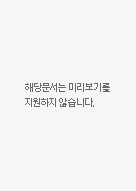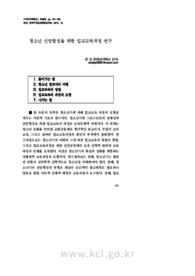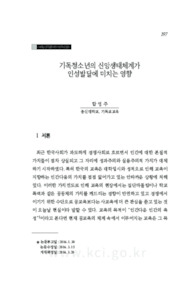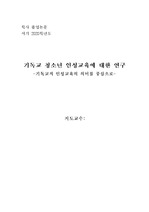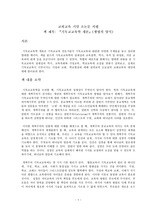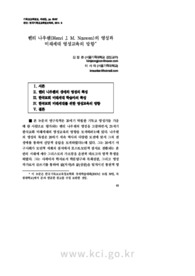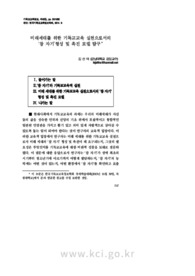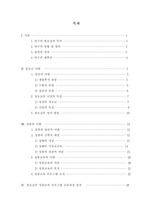

-
미리보기
서지정보
· 발행기관 : 광주가톨릭대학교 신학연구소
· 수록지 정보 : 신학전망 / 185호 / 166 ~ 201페이지
· 저자명 : 조발그니
초록
본고에서는 발달이론을 통해 청소년을 이해하고자 한다. 이를 통해 청소년 신앙교육의 방법과 과정 그리고 청소년 신앙교육의 주체인 부모와 교리교사의 역할을 제언하면서 다음과 같이 일곱 가지의 견해를 중심으로 살펴보고자 한다. 첫째, 피아제는 청소년 시기를 형식적 조작기로 보며 연역적 사고가 가능하다고 여겼다. 따라서 나눔과 묵상과 같은 추상적 사고를 통한 신앙교육을 해야 한다. 둘째, 콜버그는 도덕발달이론을 주장하면서 청소년 시기가 착한 소년 착한 소녀 지향 단계(3단계), 사회질서 도덕성이 발달한 단계(4단계)라고 주장한다. 따라서 이 시기는 독립적・도덕적 신념이 없고 강압적 신앙교육을 거부하며 의미 있는 타인이 중요하다. 셋째, 에릭슨은 청소년 시기를 정체감 대 정체감 혼미로 본다. 그래서 청소년이 자신의 문제를 살펴보고 고민을 나눌 수 있도록 교회가 노력을 해야 한다. 넷째, 골드만에 의하면 청소년은 추상적・종교적 사고단계이다. 청소년은 성경을 자구적으로 해석하지 않고 신학적이며 신앙적으로 해석할 수 있는 능력을 갖는다. 따라서 주입식 신앙교육은 청소년 신앙교육에 도움이 되지 않는다. 다섯째, 파울러에 의하면 청소년은 종합적-인습적 신앙단계로서 신앙은 아직 견고하지 않고 교회의 권위를 따른다. 그럼에도 청소년은 또래의 영향을 많이 받게 된다. 여섯째, 오저에 의하면 청소년 시기는 받기 위해 주는 단계이다. 이 시기에 신(神)은 청소년들에게 분리되어 있지 않고 상호적 관계를 지닌다. 일곱째, 다양한 종교교육학자들의 의견을 종합할 때, 청소년은 성인의 신앙과 달리 아직 성숙되지 않아 적절한 신앙교육의 개입이 필요하다. 위의 학자들의 견해를 살펴보아 필자는 청소년의 신앙교육에서 다양한 나눔 중심 교리방법을 제언하였다. 또한 청소년의 신앙교육은 주제중심과 신약 성경을 토대로 되어야 한다고 제언하였다. 그리고 나눔은 개방적이어야 하며 자기주도적 체험중심 신앙교육을 제언하였다. 청소년 신앙교육을 위해서는 부모의 신앙심이 선행되어야 하며 교리교사들이 교육학적 심리학적 지식을 갖추어야 함을 주장하였다.영어초록
This study attempts to understand adolescents in light of developmental theory. In addition, it proposes methods and curricula for faith education of adolescents and roles that might be played by both parents and catechists within this process.
The claims set out in this study are as follows. First, according to Piaget, adolescents at the formal operational level of development are capable of thinking hypothetically and deductively. Thus, abstract thinking, such as sharing, meditation and faith should be part of their education. Second, Kohlberg protests that adolescents are between the third and fourth steps of development: promoting good boy/good girl models. But he proposes that they are moving towards a fourth step of social order and morality. Since they have no independent moral beliefs, young people can reject imposed faith education thus making the role of significant others important. Third, Erikson claims that for adolescents, identity issues are extremely confusing. Recognizing these difficulties the church is endeavoring to engage with these problems. Fourth, according to Goldman, young people are at the stage of having religiously abstract ideas. They have the ability to theologically interpret the Bible as opposed to literal interpretation. This realization raises serious difficulties regarding the use of ‘cramming’ methods in faith education for the young. Fifth, according to Fowler young people are at a synthetic-conventional stage of faith which means that their faith is not firm and they may simply comply with church authority. Also, many teenagers are subject to the influence of peers. Sixth, Oser states, there is a stage for adolescents where giving is in order to receive (Do ut Des). During this stage, God is not sensed as separate from them but has a mutual and reciprocal relationship. Seventh, in the opinion of various religious education scholars, the faith of teenagers is not mature like the faith of adults and it is thus necessary to have proper faith education in place for them.
In line with the views of the above scholars, this study proposes that for youth faith education a method of education centered on sharing is needed. In addition, such a method of faith education should be based on the New Testament. Such sharing ought to be open and faith education should be a self-directed experience.
Finally two additional elements are considered: for faith education to successfully take place the parents’ religious beliefs ought to precede that of their children and catechists involved in religious education should have a sound pedagogical and psychological knowledge of educational methods.참고자료
· 없음태그
-
자주묻는질문의 답변을 확인해 주세요

꼭 알아주세요
-
자료의 정보 및 내용의 진실성에 대하여 해피캠퍼스는 보증하지 않으며, 해당 정보 및 게시물 저작권과 기타 법적 책임은 자료 등록자에게 있습니다.
자료 및 게시물 내용의 불법적 이용, 무단 전재∙배포는 금지되어 있습니다.
저작권침해, 명예훼손 등 분쟁 요소 발견 시 고객센터의 저작권침해 신고센터를 이용해 주시기 바랍니다. -
해피캠퍼스는 구매자와 판매자 모두가 만족하는 서비스가 되도록 노력하고 있으며, 아래의 4가지 자료환불 조건을 꼭 확인해주시기 바랍니다.
파일오류 중복자료 저작권 없음 설명과 실제 내용 불일치 파일의 다운로드가 제대로 되지 않거나 파일형식에 맞는 프로그램으로 정상 작동하지 않는 경우 다른 자료와 70% 이상 내용이 일치하는 경우 (중복임을 확인할 수 있는 근거 필요함) 인터넷의 다른 사이트, 연구기관, 학교, 서적 등의 자료를 도용한 경우 자료의 설명과 실제 자료의 내용이 일치하지 않는 경우
“신학전망”의 다른 논문도 확인해 보세요!
-
목적론적 세계관과 성사의 사효성의 연관성에 대한 기초신학적 연구: 칼 라너를 중심으로 34 페이지
성사는 그것을 주는 사람이나 받는 사람의 의로움이 아닌 하느님의 능력으로 이루어진다. 정확히 말해 ‘사효적으로’(ex opere operato) 곧 ‘성사 거행 그 자체로’ 효력을 가지는 것이다(『가톨릭 교회 교리서』 1128항 참조). 가톨릭교회의 이와 같은 성사 이해는 트리엔트 공의회(1547) 이후 여전히 교회의 공식 입장으로 남아 있으며, 교회는 이.. -
성경 안에서 옷의 상징적 의미 34 페이지
본고는 성경 안에 드러나는 옷의 상징적인 의미를 살펴보는 연구이다. 창세기의 가죽옷부터 묵시록의 흰옷에 이르기까지 옷은 인류의 영적인 신분을 드러내는 상징이다. 창세기 2-3장에서는 옷의 일반적인 기능 이외에도 옷을 입어야 하는 이유를 원조의 수치심(창세 3,7 참조)에서 찾는다. 창조주 하느님에 의해 질서 지어진 낙원에서는 어떠한 옷도 인간에게 필요하지 ..
찾으시던 자료가 아닌가요?
지금 보는 자료와 연관되어 있어요!
문서 초안을 생성해주는 EasyAI
